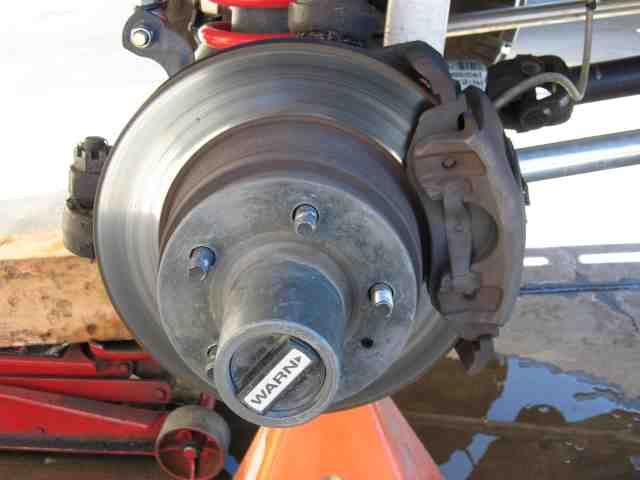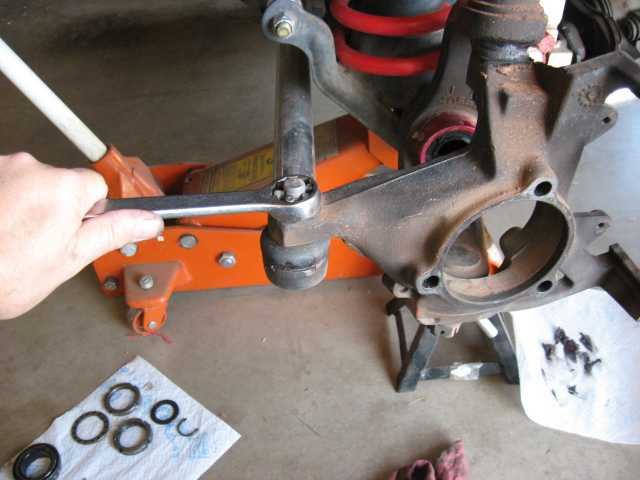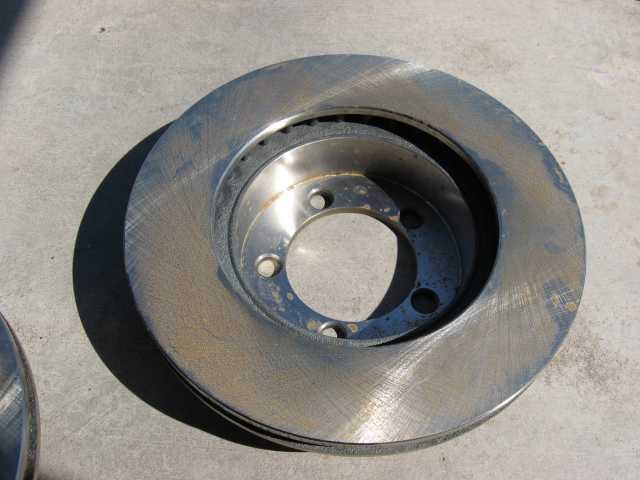NOTE: This conversion alters one of the safety devices (the brakes) on your vehicle. If you decide to undertake this conversion, it should be performed by personnel who are competent to conduct such alterations to a vehicle. This conversion will result in changes to your vehicle’s handling and braking ability. If in doubt, consult the services of a professional.
Anyone with a TJ, Rubicon, XJ, etc. knows that the stock braking system is a compromise if you are running 35″ or larger tires. Panic stopping on the freeway can quite literally cause you to panic as you find your vehicle not stopping as fast as you want. If you run a 4:1 transfer case with an automatic transmission and deep gearing in your differentials, you probably know how difficult it is to stop on the trail. Overdriving your brakes is pretty common with this kind of setup.
Several years ago, I installed a Vanco hydroboost unit to improve braking performance. It has done me well during the past few years and with my fairly recent auto tranny transplant, I’m glad I had it. I can stop on the trail and over driving my brakes is not an issue.
Last year, Vanco released a big brake kit with some design assistance by my friend Blaine Johnson. It was a more elegant solution than the hydroboost. Don’t get me wrong….the hydroboost works. However, the big brake kit doesn’t require a new power steering pump, PS cooler, new master cylinder, etc. It does come with new steering knuckles (a core charge is accessed for your old knuckles) but installing them is not that difficult. And the braking results, once installed, will put a smile on your face.
My kit was a little different because of my Warn hub conversion. Vanco provides a version of the kit to support those with the small Warn hub conversion. This write-up covers the installation of the Vanco Big Brake Kit on a TJ with that Warn hub conversion. As if that was not enough, I also have the TBT true cross over steering. This required that TBT modified knuckles be sent to Vanco for the necessary machine work and then supplied with the kit. My congratulations to Vanco for making this kit available for those of us that have modified steering and small hubs.
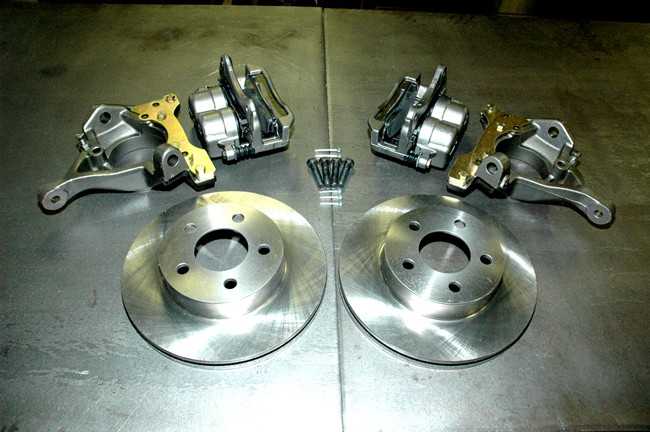
The kit contains everything you need to complete the installation. New rotors, new dual piston calipers, new Performance Friction disc brake pads, and modified TJ steering knuckles that have been machined to accept the dual piston calipers. It even includes the replacement cotter pins for the tie rod and ball joints and copper washers for the brake lines. It is a complete kit all the way down to the install documentation with the exception of the red Loctite needed for the caliper mounting bolts. Most Jeepers will have a bottle in their tool bag or their garage. If you don’t, get a bottle….you’ll use it for other Jeep mods.
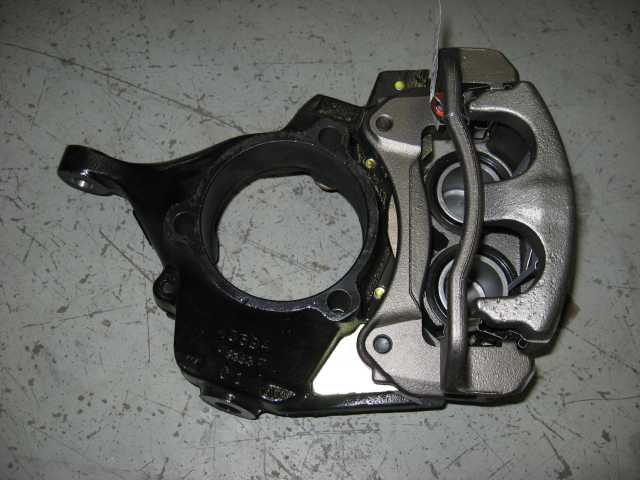
Here is one of the steering knuckles with the dual piston caliper bolted to it. The knuckles ship with the calipers attached to them. There are two caliper mounting bolts that are not tighten down. Remove these and the caliper is separated from the knuckle for installation on the TJ.
When it comes time to overhaul/replace the calipers, rotors, and pads, the parts can be obtained at virtually any auto parts store. For the pads and calipers, ask the counter person for those fitting a ’95~’01 Ford Explorer 2WD or 4WD vehicle. For the rotor, it’s the same years but it must be for the 4WD Explorer model. The 4WD rotor is a floating rotor that fits over the wheel studs and registers on the unit bearing pilot hub. It is nice to see that Vanco is using a commonly available off-the-shelf application for this kit instead of a high end expensive/hard to find unit or worse yet, something proprietary.
Time to start on the installation. This took me about a half day to complete. The 2nd side went quite a bit faster than did the first side. If you have a wrenchin’ buddy, it should go faster, especially with the kit I did as I had to do some extra steps with the Warn hubs.
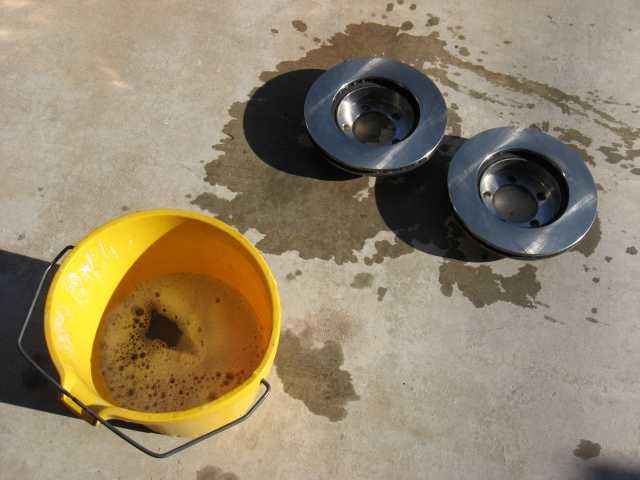
The first thing to do is to mix some laundry detergent and water together in a bucket. Scrub the rotors with a soapy brush to remove the manufacturer’s protective coating. Be sure to scrub the rotors clean, then rinse them and set them off to the side to dry. We’ll get back to them later on. (yes, they will rust)
Please note that it is possible that some rotors may ship with a different kind of protective coating which is not intended to be washed off. Vanco will add appropriate info to the kit to make you are aware of this.
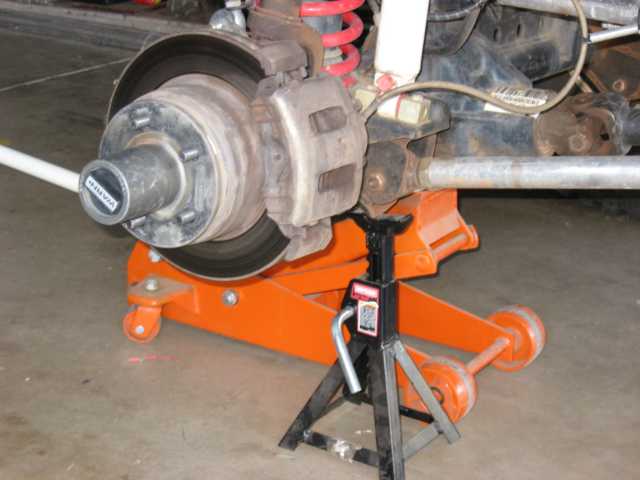
I started on the driver’s side by removing my Maxxis Trepador tire. When working on projects like this, be sure to use a jack stand along with your floor jack. Do NOT trust the floor jack to support the axle by itself. Likewise, do NOT use cinder blocks and other such things as a substitute for the jack stand.
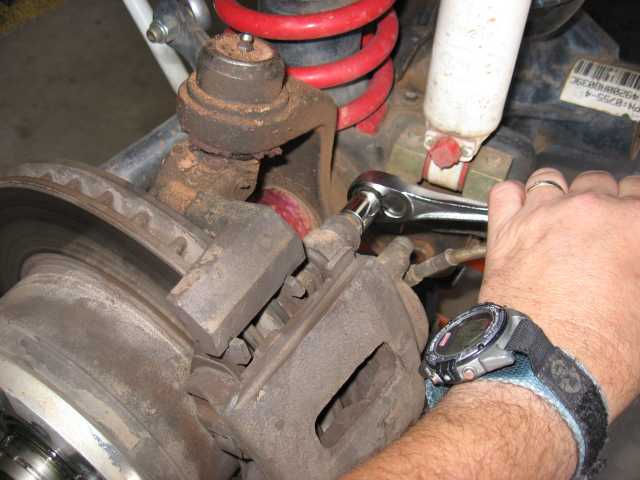
With the tire removed, I grabbed a 13mm socket and removed the two caliper mounting bolts. While these are not used in the new kit, hang onto these as your friend will eventually bend or strip one and you’ll be the hero when you have one to save the day.
Vanco Big Brake Kit
Time to pull the Warn hub. It is necessary to disassemble the hub since the wheel studs must be pressed out in order to remove the old rotor and then pressed back in with the new rotor attached.

With the caliper out of the way, it is time to get the hub off of the spindle. I labeled the above photo with the names Warn uses in their hub conversion installation docs to make it a little easier.
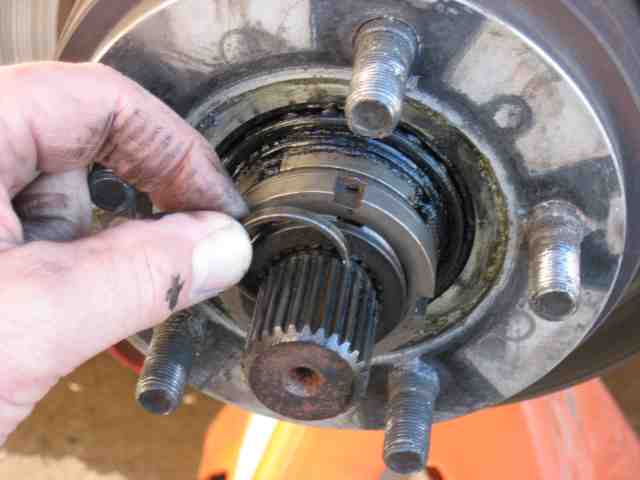
Remove the axle retainer. I use a needle nose pliers to push the open ends of this springy clip of the groove that is machined into the axle stub shaft. Be careful you don’t “pop” it across the driveway or garage floor into some unknown place. If you do, your spouse will have to come out to the garage to find it for you. (don’t ask me how I know)
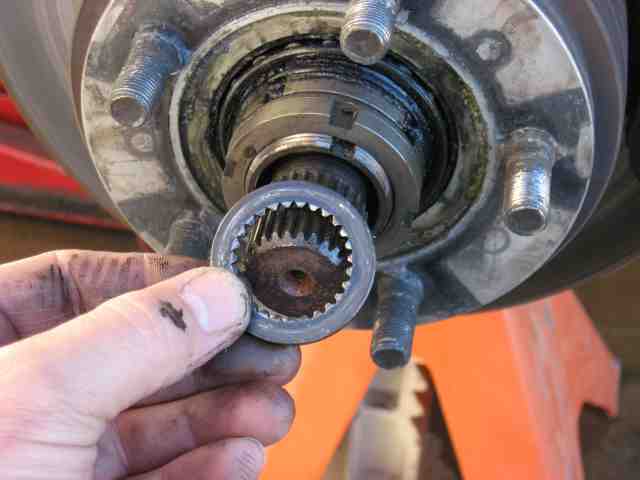
Slide the spindle washer over the splines of the axle stub shaft. You will need to line up the splines of the washer to those on the stub shaft so you can slide it off the shaft.
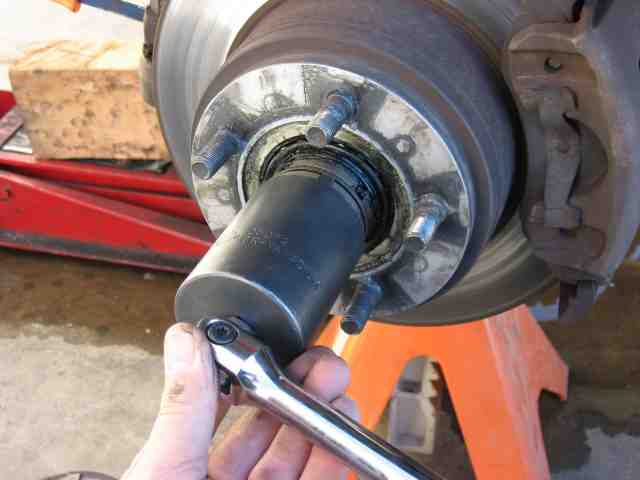
Using a Dana 44 spindle nut socket, remove the outer spindle nut. This is normally torqued to 150 foot pounds so you may want to use a 18″~24″ break bar to break it loose. What….you don’t have a spindle nut socket? They can usually be had at an auto parts store for about $12~$15. I got mine from the local Pep Boys a number of years ago. Unscrew the outer spindle nut (once you break it loose) and set it aside.

With the outer spindle nut out of the way, the lock washer can be slipped off of the spindle. Set it aside too.
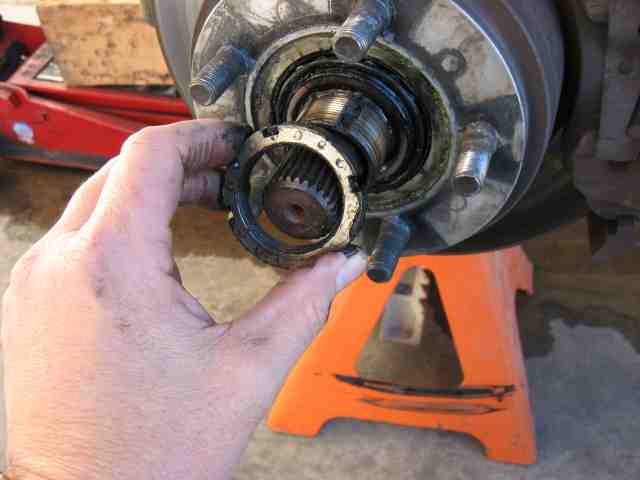
Now remove the inner spindle nut. You may or may not need to coax it loose with the spindle nut socket. It is not torqued very tight so is should be very easy to unscrew.
Vanco Big Brake Kit
OK….you now should have unobstructed access to the outer bearing. If it doesn’t slip out of the hub, pull the hub a half inch towards the end of the spindle (away from the vehicle) and then push it back into position. The bearing will have pushed out about a half inch and you should now be able to grab it. Set the bearing aside.

Now slide the rotor/hub assembly off of the spindle. What you have left is the spindle with the axle shaft running through the middle of it. Both of these will be removed in the next steps.
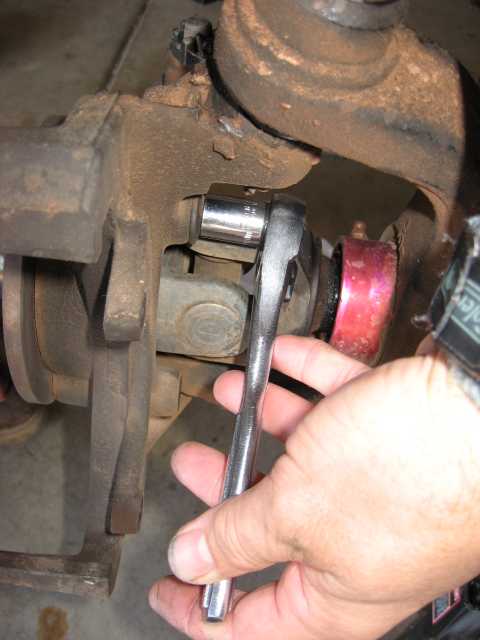
The spindle is held in place with three bolts that are accessed from the back side of the knuckle. They are twelve point bolts (not the common six point that you see most everywhere else) and if memory serves me correctly, of the 13mm size. Remove these three bolts and set them aside. You will re-use them during the assembly process.
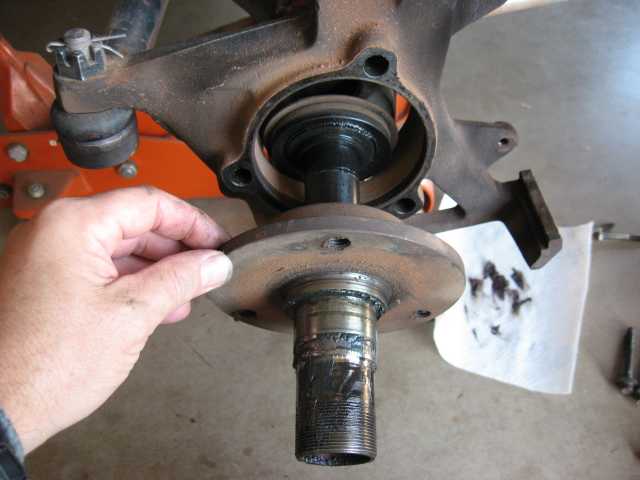
With the mounting bolts removed, pull the spindle straight out of the steering knuckle. It’s possible it is rusted into place. A hint here…..use anti-seize compound on the mounting surface of the spindle where it slips into the knuckle when you reassemble it. If you had problems getting it out this time, it should be easier the next. Set the spindle aside for later use.
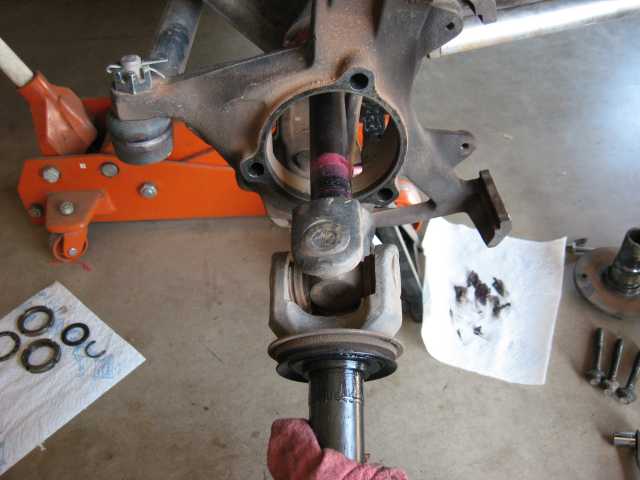
The axle shaft can now be removed by pulling it through the center of the knuckle. Set the axle shaft assembly aside for now. By the way, if you haven’t upgraded your Warn hub conversion to chromoly inner shafts, now would be an excellent time to do so.
Vanco Big Brake Kit
Almost there…..not too much left and the steering knuckle will be removed. Next, remove your tie rod from the steering knuckle. Your tie rod may not look like mine. I’ve been using the Toys by Troy true cross-over steering for the past four years. I finally replaced the 1 ton tie rod ends just before going to Moab for the 7th Annual JeepsUnlimited Moab Run this spring….so I can’t complain about the low maintenance cost of this steering setup.
To remove your tie rod, remove the cotter pin from the stud and then unscrew the castle nut with the appropriate wrench. Leave about 3 or 4 threads engaged on the nut (do not remove it).
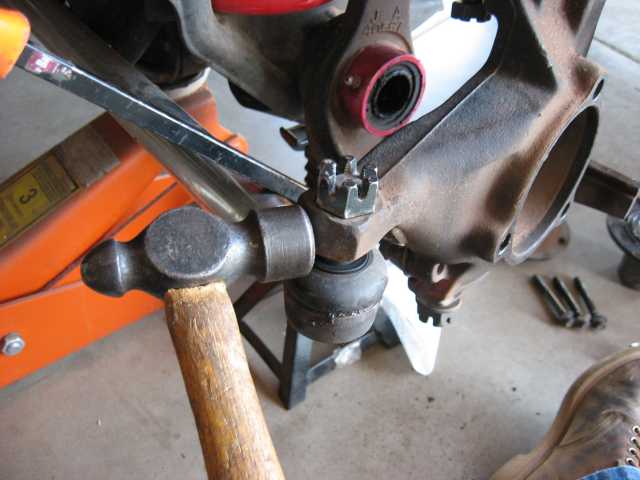
Using a large hammer (OK, I admit this isn’t a very large hammer but the again, I installed these tie rods just a couple of weeks ago and was certain they wouldn’t be rusted in place), strike the front of the steering knuckle. The resulting blows will jar the tie rod stud loose from the tapered steering knuckle hole. The castle nut that you did not remove will prevent it from falling out.
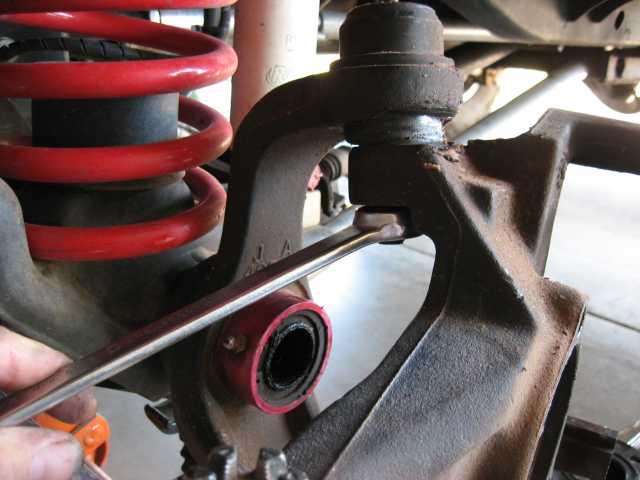
The upper ball joint is next. Remove the cotter pin (new cotter pins are included in the big brake kit) and then remove the castle nut. Note that in the above photo, I had already knocked the steering knuckle loose (forgot to snap the photo earlier).
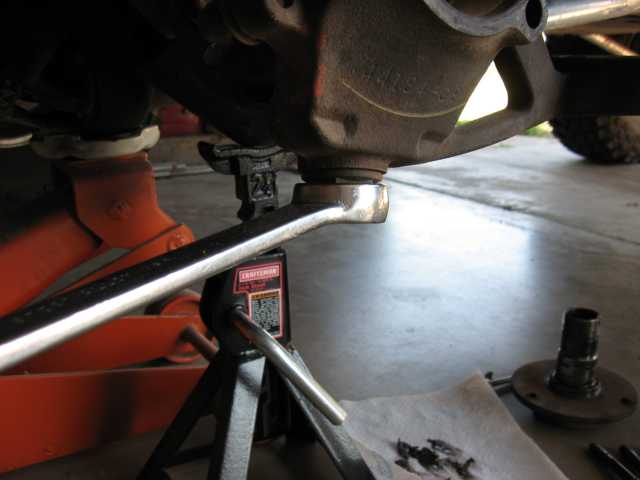
And finally, repeat the same process on the lower ball joint by removing the cotter pin and removing the nut. When you have verified that the stud threads are in good shape, screw the nut back onto the stud, engaging about 3 or 4 threads. You need to ensure that the nut can be removed as some times the end gets a little nicked on the trail. Once the knuckle is knocked loose, there is nothing to hold the stud while you unscrew the nut so you need to be certain it will come off easily.
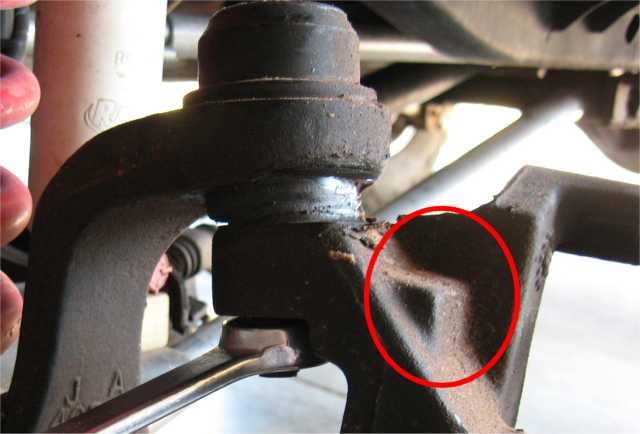
Once again, using a large hammer (I opted for a brass one this time as it was bigger than the one I used on the tie rod and my knuckles haven’t been off the TJ since I bought it), strike the knuckle on the little shelf (at the location circled in red). The resulting downward blows will jar the steering knuckle off of the ball mount studs and the lower castle nut that was left on will prevent the knuckle from dropping on your toes (you are wearing flip-flops, right?…..seriously, I hope you are not!). Now remove the nut and set the steering knuckle aside. Do NOT throw the knuckle away as it is worth some bucks when you return it to Vanco for your core charge.
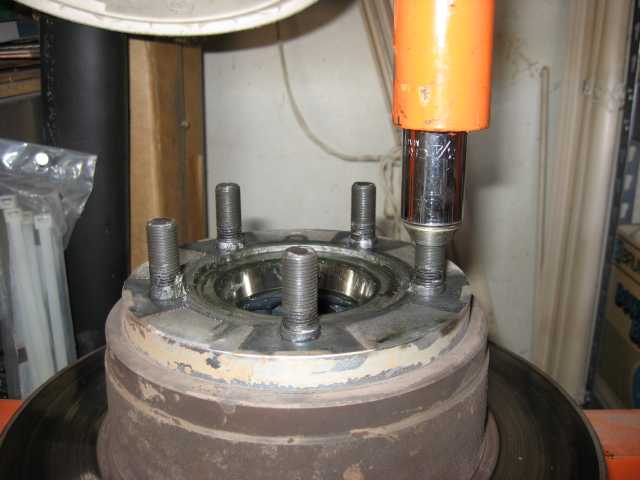
With the knuckle now removed from the vehicle, I turned my attention back to the Warn hub. The wheel studs on the Warn hub conversion attach the rotor to the hub. In order to mount the new rotor that came with the Vanco kit, I had to first remove the old rotor from the hub. I used my hydraulic press to push the studs out of the hub. In order to avoid damaging the stud threads, I screw an old stock lug nut onto the thread and then slip a 3/4″ socket over the lug nut. Finally, the ram of the press is lowered down onto the top of the socket (a nice flat surface and quite a bit larger than the 1/2″ stud) and pressure is applied to push the stud out. This is repeated for the remaining four studs.
Vanco Big Brake Kit
Meanwhile, back at the ranch, you should have a lightly rusted rotor by now. If you don’t, you didn’t get the protective coating completely removed from the rotor’s surface. Don’t worry about the rust, it will be gone at the first application of your brakes when you seat the pads. Grab one of the rotors to attach to the Warn hubs.
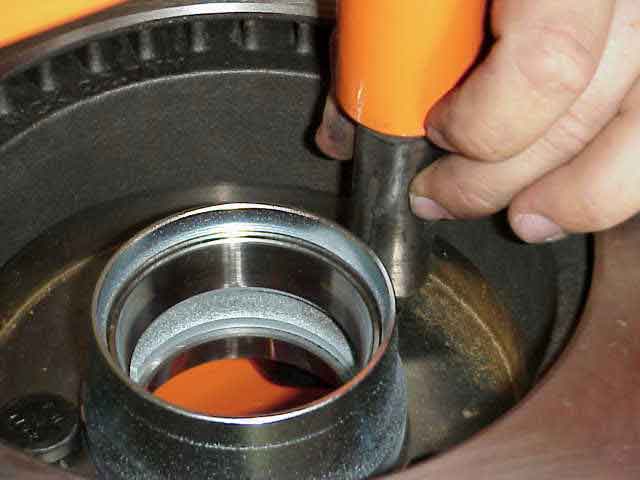
I used my hydraulic press again, this time, to press the wheel studs through the holes in the rotor and into the hub. Be sure to fully seat the studs against the surface of the rotor. Repeat this process for the remaining four wheel studs.
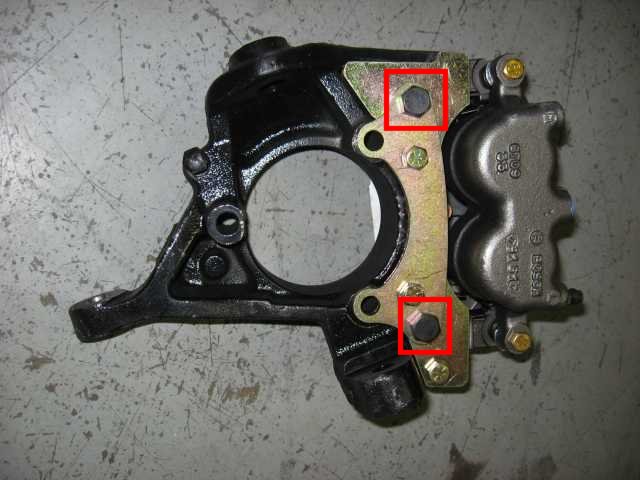
Now that you have the Warn hub and new rotor assembled, it is time to put the steering knuckle from the kit on the axle. Before that is done, remove the two bolts (boxed in red) in the above photo (they were just barely tight on mine) and set them aside. Carefully note the position of the brackets and the two round spacers. (hint….do not disassemble the other knuckle so that you’ll have a completed one for reference, just in case) Set the caliper aside.
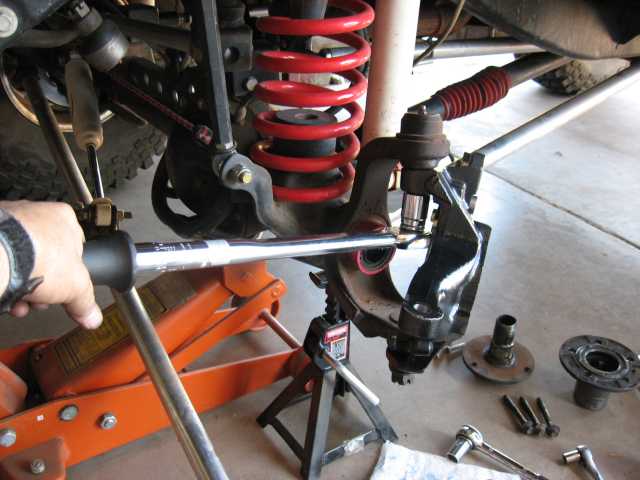
Slide the new steering knuckle onto the upper and lower ball joint studs. Thread the castle nuts onto each ball joint stud. Torque the upper ball joint to 75 foot pounds and the lower ball joint to 80 foot pounds. Use the new cotter pins supplied with the kit to secure the castle nuts on both of the ball joint studs.
Slide the axle shaft back into position in the axle tube. With the axle shaft seated into the housing, set the spindle in the knuckle and align the three mounting holts. Use the bolts you set aside to secure the spindle in position. The bolts are torqued to 75 foot pounds.
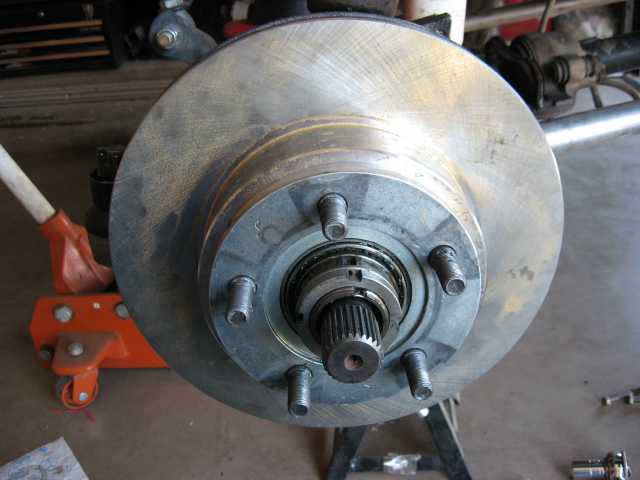
Install the wheel bearing into the outer end of the hub. Apply a thin coating of grease onto the shank of the spindle and slide the hub/rotor assembly back onto the spindle.
From here, it is a simple matter of installing the spindle nuts and torquing them to spec. Rather than repeating the entire process here, you can get the details from the last page of my hub conversion install write-up.
Vanco Big Brake Kit
Open the box of brake pads, if you have not done so already. My calipers came with one set of the metal sliders (that the brake pad backing plate rubs against) already installed in one of the calipers. If yours is this way, take the other set of sliders and install them in the remaining caliper using the assembled one as a reference. Push the pads into position in the caliper.
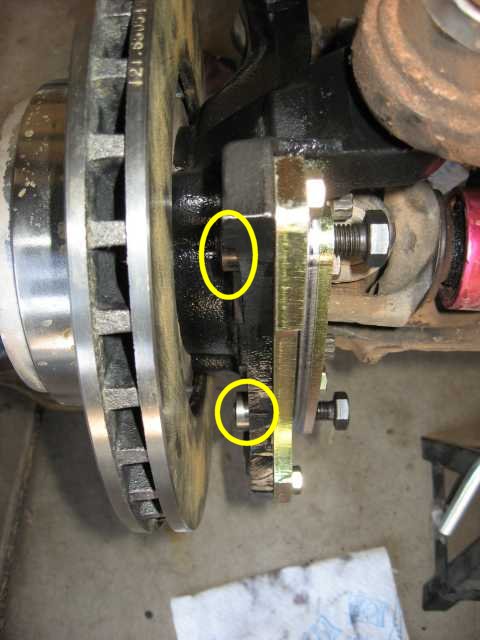
It is time to slide the caliper into position and bolt it to the mounting bracket. The two bolts that you loosened before will be used to secure the caliper into position. They both have a round spacer (circled in yellow in the above photo) that must be in position when you slide the caliper over the rotor. Be sure the threads in the mounting holes on the caliper are clean and likewise, the threads on the bolts.
Apply red Loctite to the threads on the bolts and the caliper mounting hole.
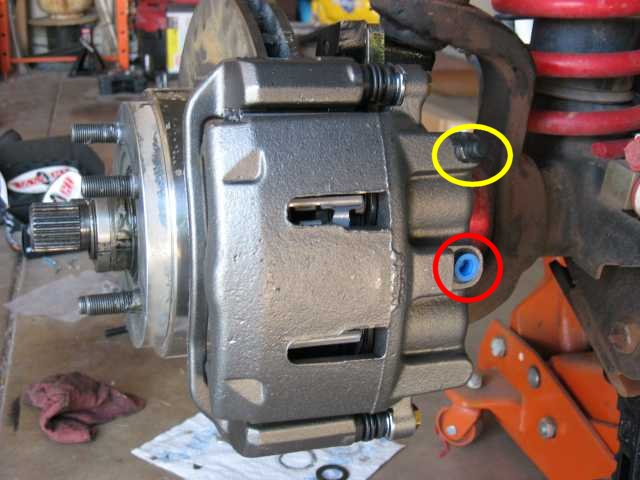
Slide the caliper over the rotor and align the mounting holes with the bolts. Tighten the bolts and torque them to 70 foot pounds. The bleeder valve should be located at the top of caliper (circled in yellow in the above photo). The threaded port for the brake line is circled in red in the above photo.
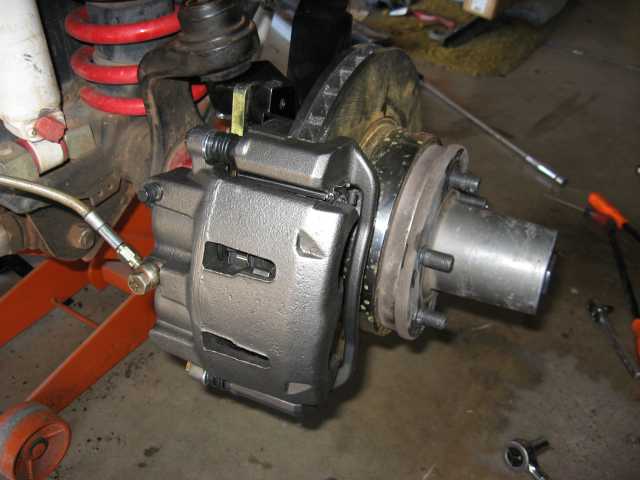
I forgot to snap a photo of the driver’s side brake hose connection so I’ll include the photo I took of the passenger side. I left my old calipers attached to the brake hoses right up until I was ready to move the brake hose over to the new caliper. Vanco provides new copper washers (two per fitting) with the kit which is nice as they are sometimes difficult to find at the local auto parts store. Remove the banjo bolt from the brake hose fitting, install the new copper washers, and then screw it into the new rotor after removing the plastic plug.
You can use your favorite brake bleeding technique or try the method I use. After you are done bleeding both sides, install your tires. It’s time to go break-in the pads and rotors.
Vanco provides all the details, nearly a page worth, of how to break in the pads and begin the bedding process on the rotors. Since I don’t wish to type all those steps here, I’ll rely on you to read the instructions and follow them closely. These need to be performed as written in order to get the most from your new brakes.
One thing I noticed after installing the tires and heading out to break in the pads…..my steering wheel was no longer centered. For my steering setup, which has the drag link attached directly to the passenger steering knuckle, a knuckle swap could certainly change the effective length of the drag link (a small amount) and thus cause the steering wheel to rotate a small amount as well. This is not a problem and will be resolved when I loosen the jam nuts on the drag link and rotate it a turn or two to change its length and center the steering wheel.
I’ve only put a few miles on the TJ since Sunday’s wrenching session but I like what I see so far. Having already had a hydroboost setup, my pedal was firm and high (typical for a hydroboost). Overall, I find it more linear, if you would…..the ability to better modulate my brakes has improved. As for stopping, no problem there. I look forward to some trail time with this new setup. I’ll try to do an update in a couple of months with my impressions as to how it is all working at that point in time.
That is about it…..it was a straight forward upgrade that went just as the instructions said it should. I like those kind! I know you will too.
Good trails to you and remember to TREADLightly!

